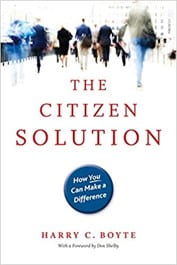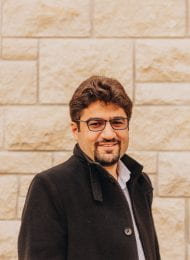
In this special book review series, authors will spotlight various resources addressing key ideas of community-engaged scholarship. The review essays offer perspectives on how stakeholders can co-create knowledge and build democratic communities.
In our final essay of the series, Keyhan Shams reviews The Citizen Solution: How You Can Make a Difference by Harry C. Boyte, 2008, Minnesota Historical Society Press. Shams overlays author Harry Boyte’s insights and tools related to “citizen movements,” with Boyer’s forms of scholarship, helping academics to situate themselves as engaged scholars and agents of social change.
 Engaged scholarship has been defined in several ways. These definitions also lead to some distinct motivations as well. Although these definitions and motivations may vary as they come from different fields, it seems they have commonalities in their goals that is social transformation. In social transformation, ideas and concepts are not objects of study but constructed by human’s relationships (Allman, 1999). Hence, if the aim is to change the situation, this happens through the change of relationships.
Engaged scholarship has been defined in several ways. These definitions also lead to some distinct motivations as well. Although these definitions and motivations may vary as they come from different fields, it seems they have commonalities in their goals that is social transformation. In social transformation, ideas and concepts are not objects of study but constructed by human’s relationships (Allman, 1999). Hence, if the aim is to change the situation, this happens through the change of relationships.
Citizen solution and scholarship of engagement
I believe that the main ideas of this book can be categorized into Boyer’s (2008) three scopes of scholarship: scholarship of integration, scholarship of sharing knowledge, and application of knowledge.
Scholarship of integration
In this type of scholarship, discoveries need to be integrated into a larger context. According to Boyer (1996), “there is an urgent need to place [scholarly] discoveries in a larger context and create more interdisciplinary conversations” (p. 3). Boyte (2008) addresses this scope of scholarship specifically in chapters eight and nine. In chapter eight, Boyte (2008) says, “every neighborhood has things that make it unique: culture and ethnic groups, stories, symbols, etc. …that understanding these can generate multiple resources for action” (p. 141). He repeats Polanyi’s (1967) “overlapping academic neighborhood” by suggesting professionals to know their neighborhoods. Here I can claim that scholarship of integration is not just integrating knowledge in a different discipline but also formal and informal/tacit knowledge within the community.
In chapter nine, he tries to redefine the role of professionals as civic professionals in the new citizen movement. Stressing the uncertainties in science, Boyte (2008) calls these professionals as “citizen scientists” that create wisdom within communities and bring knowledge of larger context.
Scholarship of sharing knowledge
Boyer (1996) says, “scholarship is a communal act. [By that] he means you have to teach what you have learned” (p. 22). Boyte (2008) shows his concern from the first pages of the book. He puts emphasis on the role of free spaces or public spaces as places where the connection between people and experts occurs. Boyte (2008) claims that as elites lost their connection to these spaces “they came to identify far more with other professionals in their field than with fellow citizens of their communities” (p. 27). In chapters three and four, again he highlights the role of free spaces like house meetings and Wheatly House where university students, directors, and officials in Minnesota would gather and share their knowledge and raise consciousness among the community.
Chapter ten also talks about the shared knowledge between people and officials and redefines the role of government as a catalyst. Besides the necessity of civic revival, Boyte (2008) highlights the necessity of government renewal. He demonstrates that how government could change its identity from a vending machine to barn raising. Boyte (2008) states that people and leaders hardly turn their communication into relationships. He contends that establishing relationships means moving into power, being able to negotiate, compromise, understanding each other, and building partnerships.
Application of knowledge
Engaged scholars are reflective practitioners and transformative learners (Mezirow, 2000; Schon, 1978). According to Boyer (1996), “[Engaged scholars] have to move from theory to practice, and from practice back to theory, which in fact makes theory, then, more authentic” (p. 23). To do so and renew theory and practice, Hall (2001) says “the academic world [should] climb down from its ivory tower” (p. 273). Boyte (2008) stresses this in chapter one saying that the idea that people are deficient, and elites should rescue them is crackpot conventional wisdom. He introduces “action taking”, in chapter seven, as a separate civic skill for scholars and declares that scholars should know sharing the knowledge, talents, and capacities with people can make an effective public work happen. He shows how integrating the Public Achievement program in the core curriculum in the University of Minnesota and Minneapolis Community and Technical College led to “deep change in young people’s sense of themselves, their relationship to the world, and their activities” (Boyte, 2008, p. 113).
So what?
Citizen Solution has three main lessons learned for scholars. First, scholars need to reframe their identity in society as civic professionals. They need to integrate their knowledge not only with other academic disciplines and policy makers but also with informal tacit knowledge within the communities.
Second, scholars need to gain relational intelligence to move from disciplinary approach to interdisciplinary, and then transdisciplinary approaches. Scholars need to join free spaces like house meetings, public gatherings, community-based organizations, local schools as well as create democratic institutions and collaborative platforms where they can share their knowledge with community members, practitioners, youth, teachers as well as policy makers, and other academics. As Boyte (2008) argues people are not consumers and learners anymore, they are teachers. Let’s imagine citizens show up in university or school classes as peers or teachers. Let’s imagine civic professionals live in communities and experience civic life and culture.
And third, civic professionals need to act as reflective practitioners. Boyte (2008) suggests that in new citizen movements, we need more actions than before not only to test the theory and make it contextual but to unleash the human energy within the community. Civic professionals should always put their knowledge under evaluation and engage in critical reflection while communicating with people rather than acting as professionals who know the problems and prescribe the solutions. Universities, as the gateways of experts, play a major role by training civic scholars and embedding civic engagement in their curriculums. They can also provide students with service-learning, action research projects, and community-based participatory research projects (Post et al., 2016).
References
Boyer, E. L. (1996). The scholarship of engagement. Bulletin of the American Academy of Arts and Sciences, 49(7), 18. https://doi.org/10.2307/3824459
Boyte, H. (2008). The citizen solution: How you can make a difference. Minnesota Historical Society.
Mezirow, J. (2000). Learning as transformation: Critical perspectives on a theory in progress. Jossey-Bass.
Polanyi, M. (1967). The tacit dimension. London: Routledge & K. Paul.
Post, M.A., Ward, E., Longo, N.V., & Saltmarsh J. (Eds.) (2016). Publicly Engaged Scholars: Next-Generation Engagement and the Future of Higher Education. Stylus.
Ramaley, J. (2001). Why do we engage in engagement? Metropolitan Universities, 12(3), 13–19.
Schon, D. (1983). The reflective practitioner: How professionals think in action. London: Temple Smith.
Shultz, L., and Kajner, T. (2013). Engaged scholarship: The politics of engagement and disengagement. Springer.
About the author
 Keyhan Shams is a Ph.D. student in K-State’s leadership communication program. He has a background in urban and regional planning and served as a campaign manager and leadership coach in Iranian cities, slums, and informal settlements over the last five years. Keyhan is curious about the distance between learning and practicing leadership in the public sphere. Now, he works in KLC’s Third Floor Research program as a graduate research assistant. Check out more from Keyhan on his online platform.
Keyhan Shams is a Ph.D. student in K-State’s leadership communication program. He has a background in urban and regional planning and served as a campaign manager and leadership coach in Iranian cities, slums, and informal settlements over the last five years. Keyhan is curious about the distance between learning and practicing leadership in the public sphere. Now, he works in KLC’s Third Floor Research program as a graduate research assistant. Check out more from Keyhan on his online platform.
